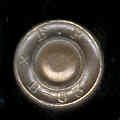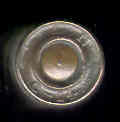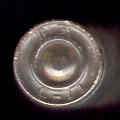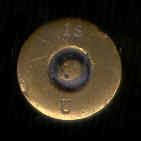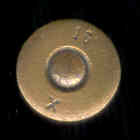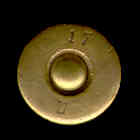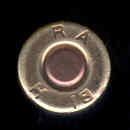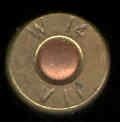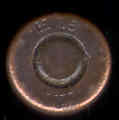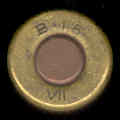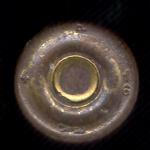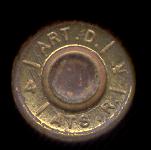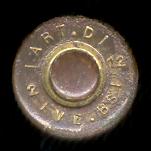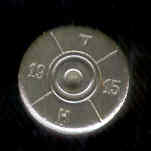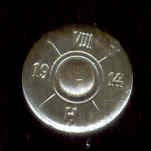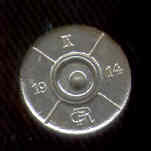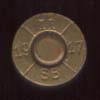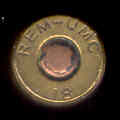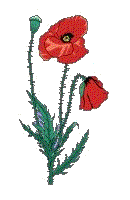
The
Western
Front
Museum
Last updated:
Identification
Pistol & rifle cartridges
Headstamps (small calibre)
Rifle clips
Howitzer & canon cartridge cases
Headstamps (large calibre)
Fuze, primer & shell markings
















Small arms calibre markings on base of cartridge cases and rifle clips
|
Here we put some of the most common shell body and base markings for you on paper which will finally enable you to understand some of these markings and establish its origin. The other marks could be a reference to the propellant, bullet type, date and month of manufacturing. |
Dear Visitor,Should you happen to have or know about a cartridge case which is dated before 1919 and have no longer use for
it (dislike brass polishing !) or is just gathering dust in some forgotten corner, we would very much like to hear from you. A cartridge case which has been transformed into a vase, lamp or any other shape (socalled "trench art") is also more than welcome. The museum's collection can always use expansion. |
These lists were put together once we had established the origin of most of the cartridges
we collected over the years, and we are very much aware that they are far from complete. The other
information which will help you to determine its origin are the shell's measurements (base,
bottom, top and sometimes neck diameter and full length).
Please drop us a line if you happen to have additional information for us on the subject.
|
TOP
Identification
First of all you need to understand that every type of wapen has most of the time its own specific cartridge, either as complete unit or as separate parts: shell, primer, charge and projectile.
For determination we use two basics: the case shape and dimensions.
Cartridge shapes
straight & rimmed:
parallel-sided or slightly tapered, rim is larger than the rest of the case (for example: Webley .455).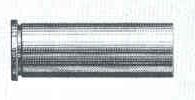
straight, rimless, semi-rimmed:
parellel-sided or slightly tapered, rim is the same diameter as the case and separated by a extraction groove (for example: Colt .45 ACP).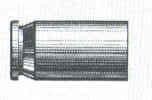
necked, rimmed:
a rimmed case with the case diameter reduced sharply towards the top of the case (for example: Lee Enfield 7.7 x 56R, Lebel 8mm).
necked, rimless:
the same as no.2 but with the case body reduced in diameter as no.3 (for example: Mauser 8 x 57).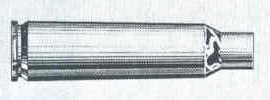
rebated, rimless:
all cases as no.2 and no.4 but with the extraction rim somewhat smaller in diameter than the base of the case.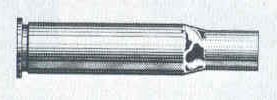
belted:
a belted case can either be rimmed or rimless, straight or necked but with a clearly visible raised belt around the case slightly forward of the rim.
Dimensions
length:
total length of the cartridge case measured from top to bottom.- mouth:
diameter at the top of the case. - rim:
diameter of the rim at the bottom of the case. - body:
diameter of the case itself.
Examples
| 7.7 x 56R | 7.7mm 56mm R | = calibre = length of the case = rimmed 8 x 57 | 8mm (7.92) | 57mm = calibre | = length of the case |
Primers
We recognize two types of primer for use in small arms cartridges:- Berdan
- Boxer
Designed by Colonel Hiram S. Berdan of the US Army Ordnance Department in the 1860s. Destinctive feature of this type of primer is that the anvil forms part of the cartridge case. A number of flasholes alongside it permits the ignition flame to pass from the primer cap to the body of the case which contains the main charge. This type of primer is used in almost every military ammunition.
Developed by Colonel Edward Boxer, Superintendant of the Royal Laboratory at the Woolwich Arsenal in 1866. This design makes use of an anvil which is a separate component forming part of the primer. The case itself has one single flas hole to allow the flash from the primer to pass. More difficult to manufacture but can easily be removed thus allowing the case to be re-used more easily. Often found in commercial ammunition.

Pistol & rifle cartridges
A summary of some of the cartridges, clips & chargers used during World War One and currently in our collection.
|
CALIBRE |
DESCRIPTION |
COUNTRY |
|---|---|---|
| 6.5 x 52.5 | Carcano M.1891 and Fiat–Revelli Modello 1914 MG | Italy |
| 6.5 x 53.5R | Mannlicher M.95 and Schwarzlose M.08 MG | The Netherlands |
| 6.5 x 55 | Swedish Mauser Model 1896 | Sweden |
| 7.5 x 23R | Revolver M1882 | Switzerland |
| 7.5 x 53.5 | Schmidt-Rubin Model 1889 | Switzerland |
| 7.5 x 55 | Schmidt-Rubin Model 1896/11 | Switzerland |
| 7.62 x 53R | Mosin-Nagant M.1891 | Russia |
| 7.62 x 63 | Springfield P.17, Browning Automatic Rifle M1918 (BAR) and Colt–Browning M1895 MG (.30-06) | USA |
| 7.63 x 25 | Mauser C96 | Germany |
| 7.65 x 17 | FN M1900, Ruby and Colt Model 1903 (.32ACP) | Belgium, France, USA |
| 7.65 x 21 | Parabellum P.08 | Germany |
| 7.65 x 53.5 | Argentine Mauser M1891 & M1909 Belgian Mauser M1889 | Argentina, Belgium |
| 7.7 x 56R | Lee Metford/Enfield/P14, Lewis, and Vickers MG (.303) | England |
| 7.92 x 57R | Schwarzlose M.08 MG | The Netherlands |
| 8 x 27R | Modèle 1892 revolver | France |
| 8 x 50R | Lebel M1886, Berthier Model 1890/1916, Chauchat and Hotckiss M1914 MG | France |
| 8 x 50.5R | Mannlicher M.1888, M.1888/90, M.1895 and Schwarzlose M.7 MG | Austro-Hungarian |
| 8 x 57 | Mauser M.1888, M.1891, M.1898 amd Maxim MG | Germany |
| 8 x 58R | Krag–Jørgensen M1889 and Madsen MG | Denmark |
| 9 x 19 | Parabellum P.08, Mauser C96 and MP18 | Germany |
| 9 x 19 | Glisenti M1910, Beretta M1915 & M1918 and Villar-Perosa MG | Italy |
| 9 x 20 | FN M1903/Husqvarna M07 (9mm Browning Long) | Belgium, Sweden |
| 9 x 23 | Steyr 1911 (Steyr 9mm) | Austro-Hungarian |
| 9 x 25 | Mauser C96 'Rote Neun' (9mm Mauser Export) | Germany |
| 9.4 x 27R | Service Revolver M1873 | The Netherlands |
| 10.4 x 38R | Peabody M1867 & Vetterli M1869-71/78 | Switzerland |
| 10.4 × 47R | Vetterli M1870 and Vetterli-Vitali M1870/87 | Italy |
| 10.6 × 25R | M1879 Reichsrevolver | Germany |
| 11 x 17.8R | Chamelot-Delvigne service revolver Model 1873 | France |
| 11 x 59R | Fusil Gras Mle 1874 | France |
| 11.3 x 50R | Beaumont M1871 & M1871/88 | The Netherlands |
| 11.35 x 23 | Colt M.1911 (.45 ACP) | USA |
| 11.4 x 22R | Webley (.455) service revolver | England |
| 11.5 x 58R | Werndl M77 | Austro-Hungarian |
| 13 x 92HR | Mauser Tankgewehr M18 | Germany |
Don't be confused by designations like .303, .455 or .30-06 which simple needs to be read as 303/1000 of one inch (or 455/1000 or 30/100). The '06' in .30-06 refers do the introduction date 1906.
TOP
Headstamps
TOP

|
MARKING |
DESCRIPTION |
REMARK |
COUNTRY |
|---|---|---|---|
| VII | Mk. VII bullet | .303 British | England |
| VIIG | Mk. VII bullet with tracer | .303 British | England |
| AA C | Pirotecnico di Capua, Adamo Aldo (Chief Inspector) | 6.5 x 52.5 Carcano | Italy |
| ABS | Atelier de Construction de Bourges | France | |
| AD | Cartoucherie de Saint à Douai | France | |
| AI | Artillerie-Inrichtingen Hembrug | The Netherlands | |
| APX | Ateliers de Construction de Puteaux | France | |
| APX.BS | Ateliers de Construction de Puteaux | Brass supplied by Atelier de Laminage de l'Ecole de Pyrotechnie de Bourges | France |
| APX.CY | Ateliers de Construction de Puteaux | Brass supplied by Établissements Crozet-Fourneyron de Chambon-Feugnerolles | France |
| APX.D | Ateliers de Construction de Puteaux | Brass supplied by Société d'éléctro-métallurgie de Dives | France |
| APX.M | Ateliers de Construction de Puteaux | Brass supplied by Établissements Mouchel | France |
| APX.P | Ateliers de Construction de Puteaux | Brass supplied by Société Française des metaux, de Couéran | France |
| APX.R | Ateliers de Construction de Puteaux | Brass supplied by Tréfileries et Laminoirs du Havre à Rugles | France |
| APX.S | Ateliers de Construction de Puteaux | Brass supplied by Compagnie française des Métaux de Sérifontaine | France |
| AR.BS | Atelier de Construction d'Alger | Brass supplied by Ateliers de Laminage de l'Ecole de Pyrotechnie de Bourges | France |
| AR.P | Atelier de Construction d'Alger | Brass supplied by Société Française des metaux, de Couéran | France |
| ARS | Ateliers de Construction de Rennes | France | |
| ART.D | Artillerie D - Balle D (= Désaleux) | 8x50R Lebel | France |
| ART.M | Artillerie modifié - Balle M (with modified cartridge base) | 8x50R Lebel | France |
| ATE | Atelier de Toulouse | France | |
| ATS | Atelier de Construction de Tarbes | France | |
| ATS.C | Atelier de Construction de Tarbes | Brass supplied by Compagnie Française des Métaux (CFM) at Castelsarrasin | France |
| AVE | Atelier de Valence | France | |
| AVX | Atelier de chargement de Vénissieux | France | |
| B | Birmingham Metal & Munitions Co., Birmingham | England | |
| BP B | Pirotecnico di Bologna, Pietro Boschesi (Chief Inspector | 6.5 x 52.5 Carcano | Italy |
| BS | Atelier de Laminage de l'Ecole de Pyrotechnie de Bourges | Brass supplier 8x50R | France |
| C | Munitionsfabrik, Cassel | Germany | |
| CA B | Pirotecnico di Bologna, Alfredo Cavalli (Chief Inspector) | Italy | |
| CA C | Pirotechnia di Capua, Alfredo Cavalli (Chief Inspector) | Italy | |
| CAC | Colonial Ammunition Co., Auckland | New Zealand | |
| CY | Etablissements Crozet-Fourneyron | Brass supplier 8x50R | France |
| D | Königliches Arsenal, Dresden | Germany | |
| DAL | Dominion Arsenal, Lindsay | Canada | |
| DC | Dominion Cartridge Company | Canada | |
| DM | Deutsche Metallpatronenfabrik, Karlsruhe | Germany | |
| DTE | Dépôt de Toulouse | France | |
| DWM | Deutsche Waffen- und Munitionsfabriken | Germany | |
| E | Eley Cartridge Factory, London | England | |
| E & G | Ehrich u. Graetz, Berlin | 8x57 | Germany |
| EDB | Etablissements Delaunay Belleville | France | |
| H | Rheinische Metallwarenfabrik, Düsseldorf | 8x57 | Germany |
| G | Greenwood & Batley, Leeds | England | |
| G | Württembergische Metallwarenfabrik, Geislingen a/d Steige | 8x57 | Germany |
| GD | Gustav Genschow, Durlach in Baden. | 8x57 | Germany |
| Ge | Gustav Genschow A.G., Durlach | 8x57 | Germany |
| GM | Grüneberger Metallwarenfabrik | 8x57 | Germany |
| GR (monogram) | Georg Roth, Vienna | 8x50.5R | Austria |
| H | Rheinische Metallwarenfabrik, Düsseldorf | 8x57 | Germany |
| H | Hirtenberger Patronen- Zündhütchen- und Metallwarenfabrik | 8x50.5R | Austria |
| H | National Brass and Copper Tube Co., Hastings, New York | USA | |
| J | Birmingham Metals & Munitions Co. Waltham, Essex | England | |
| K | George Kynoch Ltd., Birmingham | England | |
| KN | Kings Norton Metal Co. | England | |
| L | Lindener Zündhütchen- und Thonwaarenfabrik | Germany | |
| LN C | Pirotechnia di Capua, Nicola Leggiadore (Chief Inspector) | 6.5 x 52.5 Carcano | Italy |
| M | Nobel Explosives Ltd., Glasgow | England | |
| MW | Munitionswerke Schönebeck am Elbe | 8x57 | Germany |
| N | Nobel Explosives Ltd., Glasgow | England | |
| N & S | Niebecker und Schumacher, Solingen | 8x57 | Germany |
| OS | Oberschlesishe A.G., Schönebeck an der Elbe | 8x57 | Germany |
| P | Société anonyme des Mines et Fonderies de Pontgibaud | Brass supplier 8x50R | France |
| P | Polte, Magdenburg | 8x57 | Germany |
| P | Peters Cartridge Company, Kings Mills, Ohio | USA | |
| PMF | Pulver und Munitionsfabrik, Dachau | 8x57 | Germany |
| PV C | Pirotecnico di Capua, Vincenzo Puscarella (Chief Inspector) | 6.5 x 52.5 Carcano | Italy |
| RA | Remington Arms (RA H = Hoboken) | .30-06 | USA |
| RᗑL | Royal Laboratories, Woolwich | England | |
| REM-UMC | Remingtom Arms - Union Metallic Cartridge Co., Bridgeport | USA | |
| RR | Ross Rifle Co., Quebec | Canada | |
| RS | Ateliers de Construction de Rennes | France | |
| RS.M | Ateliers de Construction de Rennes | Brass supplied by Société d'éléctro-métallurgie de Dives | France |
| RS.R | Ateliers de Construction de Rennes | Brass supplied by Tréfileries et Laminoirs du Havre à Rugles | France |
| RS.S | Ateliers de Construction de Rennes | Brass supplied by Compagnie française des Métaux de Sérifontaine | France |
| RW | Rudge Whitworth Cycle Co, Nottingham | England | |
| S | Königliches Munitionsfabrik, Spandau | 8x57 | Germany |
| S67 | Model S case made by Spandau, the 67 is the percentage copper | 8x57 | Germany |
| SB | Sellier & Bellot, Schönebeck an der Elbe. | Germany | |
| SF | Sociéte Française des Munitions | France | |
| SFM | Sociéte Française des Munitions | France | |
| TE | Atelier de Construction de Toulouse | France | |
| TE.C | Atelier de Construction de Toulouse | Brass supplied by Compagnie Française des Métaux à Castelsarrazin | France |
| TE.R | Atelier de Construction de Toulouse | Brass supplied by Tréfileries et Laminoirs du Havre à Rugles | France |
| TH | Cartoucherie de la Seine (Groupe des Tréfilerie du Havre) | France | |
| TR C | Pirotecnico di Capua, unknown (Chief Inspector) | 6.5 x 52.5 Carcano | Italy |
| TS | Atelier de Construction de Tarbes | France | |
| TS.BS | Atelier de Construction de Tarbes | Brass supplied by Atelier de Laminage de l'Ecole de Pyrotechnie de Bourges | France |
| TS.N | Atelier de Construction de Tarbes | Etablissement Navarre à Evreux | France |
| UN | RWS, Utendörffer, Nürnberg | 8x57 | Germany |
| U.S. | United States Cartridge Company, Lowell | .303 British | USA |
| U.S.C.Co. | United States Cartridge Company, Lowell | USA | |
| VE | Cartoucherie de Valence | France | |
| VE.BS | Cartoucherie de Valence | Brass supplied by Ateliers de Laminage de l'Ecole de Pyrotechnie de Bourges | France |
| VE.P | Cartoucherie de Valence | Brass supplied by Société Française des metaux, de Couéran | France |
| VE.R | Cartoucherie de Valence | Brass supplied by Tréfileries et Laminoirs du Havre à Rugles | France |
| VE.S | Cartoucherie de Valence | Brass supplied by Compagnie française des Métaux de Sérifontaine | France |
| VIS | Atelier de Construction de Vincennes | France | |
| VIS.RS | Atelier de Construction de Vincennes | Brass supplied Ateliers de Construction de Rennes | France |
| VS | Atelier de Construction de Versailles | France | |
| VS.R | Atelier de Construction de Versailles | Brass supplied by Tréfileries et Laminoirs du Havre à Rugles | France |
| VS.S | Atelier de Construction de Versailles | Brass supplied by Compagnie française des Métaux de Sérifontaine | France |
| WRA | Winchester Repeating Arms Co.,New Haven, Conn. | USA | |
| ZG C | Pirotechnia di Capua, Gaetano Zangari (Chief Inspector) | 6.5 x 52.5 Carcano | Italy |
TOP
Rifle clips (chargers)
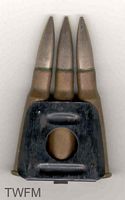 | F r a n c eBerthier rifle Model 1890, containing three 8 x 50R Lebel cartridges. |
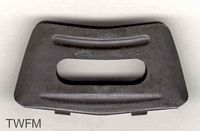 | F r a n c eBerthier rifle Model 16, containing five 8 x 50R Lebel cartridges. |
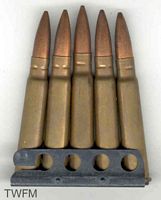 | E n g l a n dSMLE (Short Magazine Lee Enfield) clips Model I, containing five 7.7 x 56R cartridges. Also used in P.14. |
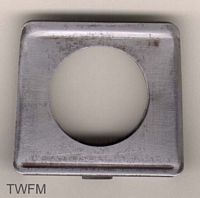 | G e r m a n yMauser rifle Model M.1888 clip, containing five 8 x 57 I (I = Infantry) cartridges. |
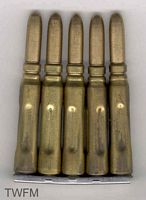 | G e r m a n yMauser rifle Model M.98, containing five 8 x 57 cartridges. |
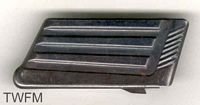 | A u s t r o - H u n g a r i a nMannlicher rifle M.1888, 1889/90 and 1895, containing five 8 x 50R cartridges. |
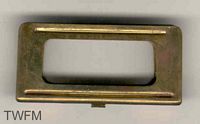 | I t a l yMannlicher-Carcano rifle M.91, containing six 6.5 x 52.5 cartridges. |
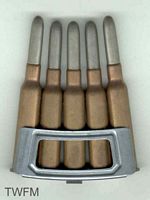 | T h e N e t h e r l a n d sMannlicher rifle M.95, containing five 6.5 x 53.5 cartridges. |
TOP
Reference list

Member of the N.V.B.M.B. (Dutch branch of the European Cartridge Research Association)
Copyright © The Western Front Museum Foundation
